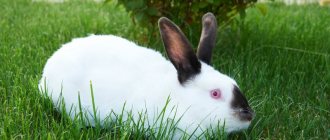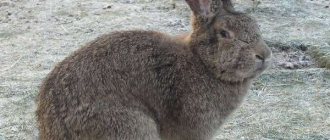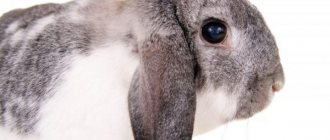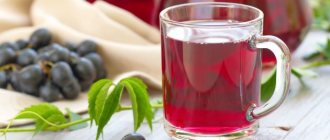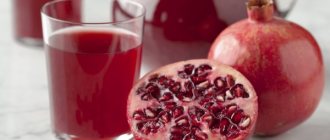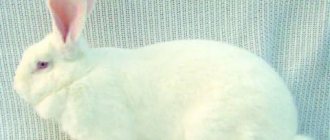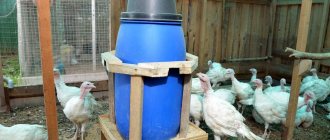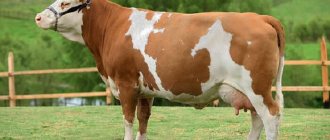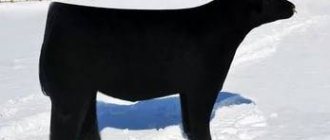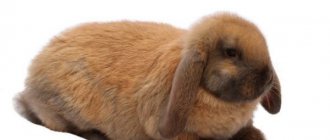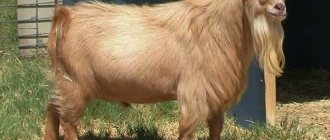History of the subspecies
In 1927, American chinchilla rabbits were brought to the USSR for the first time. They were distinguished by their small size and thick fur. After crossing with large breeds, long and targeted selection, it was possible to increase the weight of chinchillas to 5 kg.
The creation of the new breed involved hybrids obtained from crossing rodents - small chinchillas and White Giant rabbits. A new breed, the Soviet chinchilla, was officially registered in 1963.
The authors of the breeds are considered to be the rabbit breeders of two fur-bearing state farms - “Cherepanovsky” (Novosibirsk region) and “Anisovsky” (Saratov region) and specialists from the rabbit farm of the Rabbit Breeding Research Institute (established in 1932).
Origin and official registration
The breed was bred at the beginning of the last century in France by crossing several popular species: Russian ermine (Himalayan), Baveren blue and wild rabbits. The breeders chose the name “chinchilla” for the new animals because of the similarity of their color to the rodents of the same name.
To breed chinchillas, Russian ermine (left in the photo) and Baveren blue (right) were used.
Chinchilla rabbits were first presented at a Paris exhibition in 1913. Over the next decade, the animals spread widely across Europe. The breed was further modified by British breeders who crossed it with giant rabbits. As a result, it was possible to achieve an increase in the weight of adult individuals from 2.5 to 4 kg. Nowadays, in many countries they continue to raise both large animals and smaller ones - decorative representatives of this breed.
In the 20s of the last century, Soviet rabbit breeders also showed interest in “chinchillas,” but they were absolutely not adapted to local climatic conditions. Domestic specialists have done a lot of work to adapt and improve the breed: they crossed with various large rabbits (including white giants), and carried out selection under conditions of increased nutrition. Over time, it was possible to create animals suitable for breeding in all regions of Russia, early maturing, with an average weight of about 4.5-5 kg.
Smaller varieties of chinchilla rabbits are kept at home
“Soviet chinchilla” was officially included in the State Register in 1993 and today remains one of the most popular among both professional farmers and amateur livestock breeders.
Description of the breed
Soviet chinchilla belongs to the large category breeds. Chinchilla rabbits are easily recognized by their large size and beautiful fur.
Breed constitution
Main external signs:
- The body is massive, strong and slightly elongated. Length – 60-70 cm. The sternum is massive, rounded, girth – 38-40 cm. The back is long, with a curve.
- The paws are large, strong, fleshy.
- The head, in comparison with the large body, is small and neat.
- The ears are erect and of medium length.
An adult rabbit weighs from 4 to 8 kg. Average weight – 5-6 kg.
Fur and skin
Chinchilla fur is considered one of the most expensive in the world. The Soviet chinchilla has soft and fluffy fur. Color – silver-bluish. There are separate white patches on the belly and in the eye area, and a black border on the top of the tail and on the ears. In the back of the head there is a light wedge. The eyes are usually cherry-brown, but blue can also be seen.
The fur of this breed is unique; it is not only dense and beautiful, but also has a unique color. Today there are a lot of scammers who pass off the fur of these rabbits as expensive chinchilla fur. And this is no wonder, because both furs are thick, shiny, and their color is almost the same.
A distinctive feature of the breed is its heterogeneous color.
Main defects
In a litter there are often rabbits with obvious defects. Such animals are immediately rejected and separated from the herd, since they are not suitable for breeding.
The main defects of the breed include the following:
- drooping croup;
- presence of bald spots;
- uneven fur;
- presence of red color in color;
- back with a hump;
- large ears, drooping and “breaking”.
Character
The character of the Soviet chinchilla is excellent; their behavior is no different from smaller rabbits. They are also kind, sympathetic and love affection. But due to their large size, keeping them at home is too problematic.
Pros and cons of chinchilla rabbits
Many breeders classify chinchilla rabbits as a universal breed, despite the fact that it was originally used as a skin-meat variety with a focus on fur. The productivity of this breed is slightly lower in comparison with varieties of animals for meat production. However, if the animals are raised correctly, breeding chinchilla rabbits becomes very profitable due to the balance of sales of the resulting skins and meat.
Chinchilla rabbits have advantages that should be taken into account if you are going to start breeding such animals:
- High-quality fur with 50% more density compared to other rabbit breeds. In addition, do not forget about the noble grayish-blue color, reminiscent of the American rodents after which the breed was named. Due to this, fur is valued by fur manufacturers much more than the skins of ordinary rabbits.
- Large body weight. Representatives of this type of animal weigh about 5 kg; after slaughter, you can get a fairly large carcass with a lot of meat on it.
- Unpretentiousness to content. Soviet breeders were able to fully raise quite unassuming animals. Simple conditions are suitable for keeping rabbits. Easily available food is used as food.
There are not many advantages, but there are also few disadvantages. This is explained by the fairly balanced average characteristics of rabbits of this breed, which are satisfactory in many situations.
Among the disadvantages of representatives of this type of rabbit it is worth noting:
- Few offspring. At one time, a female rabbit can give birth to a maximum of 7-8 babies (sometimes a litter consists of 5-6 rabbits), which is significantly less in comparison with many other breeds of rabbits. As a result, in order to obtain numerous offspring, livestock breeders are forced to keep female rabbits in large numbers.
- Small yield of meat after slaughter. The carcass of this rabbit is approximately 4-5% smaller compared to other rabbit breeds. Initially, this figure seems quite impressive, although we should not forget that these indicators are compensated over time thanks to high-quality and expensive fur.
Economic characteristics
Soviet chinchillas are bred both in small private farms and on large livestock farms. Rabbits quickly pay for themselves, since the demand for bluish fur and dietary meat is always stable.
Economic characteristics of the breed:
- The average cost of a skin is 3,500 rubles.
- Age for slaughter – 3-4 months.
- Lean meat - suitable for children's and dietary nutrition. The meat has a minimal amount of bones and tendons. Fat contains few calories.
- The cost of sexually mature individuals is 3-4 months old, about 1000 rubles.
Chinchilla skins are readily purchased by felt and fur factories.
If you need advice on how to properly tan a rabbit skin at home, this article can be found here.
Breeds
The Soviet chinchilla was officially registered in 1963. In practice, it is this subspecies that has gained great popularity on Russian farms. These rabbits grow quite actively, especially in the first 2 months from birth. By this period, individuals gain approximately 1.8 kg, and then add about 1.5 kg of weight monthly. Newborn specimens are only 75 years old.
The giant chinchilla is similar to the previous subspecies in its main characteristics, but differs in size. Individuals are much larger and more powerful due to crossing with the Flanders breed. The abdomen of this subspecies is exceptionally snow-white. Individuals are bred for the commercial sale of skins, but produce about 7 kilograms of pure meat. By two months of life, these individuals reach the size of a Soviet chinchilla.
The large chinchilla was bred by American breeders. The breed is based on French chinchillas, which were not very common in the USSR. The large chinchilla appeared in 1919, characterized by improved meatiness and fluffiness. Experts include the power of the limbs as a breed characteristic. The fur of individuals is dense, silky and very soft. The hairs are of medium length. At the base they are dark blue, towards the middle they are pearly, and the tips are gray. The neck and paws have the same color.
The European chinchilla differs from other subspecies in its thick, shiny, velvety-to-the-touch fur. The color is light gray with dark shades. The underparts, legs and tail are usually white. The European chinchilla is also called Rex. These individuals are the most intelligent, and therefore most often become pets; they are often kept for children, as individuals are active, playful, and have a perky temperament.
The Russian chinchilla differs from its fellow subspecies in its versatility and unpretentiousness in maintenance. Unlike Rexes, Russian rabbits adapt well to different living conditions. However, individuals produce a small percentage of slaughter meat. Individuals are distinguished by the beauty of their skins, which are more pleasant to the touch in comparison with American and European representatives. Let us examine in more detail the features of the varieties in order to make the right choice for your farm.
Productivity
Large rabbits provide not only valuable bluish fur, but also tasty dietary meat. The cubs gain weight quickly; by six months they gain up to 90-95% of their weight. The main productivity characteristics are in Table 1.
Table 1
| Characteristics | Description |
| Male weight, kg | 6-7 kg, maximum – 8 kg |
| Female weight, kg | 5-6 kg |
| Number of cubs per litter | 7-8 pieces |
| Weight of a 2 month old rabbit | 1.9-2 kg |
| Meat yield at slaughter | 58-60 % |
Rabbit performance
Initially, the breed was intended to be bred for skins, and the characteristics of meat products were simply an addition. Nowadays chinchilla rabbits are bred for both meat and fur.
The quality of the fur of this type of animal significantly exceeds similar products obtained from simple rabbit breeds. Rabbit skins are popular in enterprises where fur products are produced. In addition, skins most often do not require additional dyeing, as happens with products made from the fur of ordinary rabbit breeds. The natural color looks quite representative, which allows the skins to be used in their original condition.
Meat products can be obtained from rabbits as early as 4 months of age. During this period, the average slaughter yield reaches 56-58%, which is slightly less compared to ordinary rabbit breeds (60-62%). Although it should be borne in mind that the main product obtained from breeding this type of animal is fur. In some cases, the slaughter yield for representatives of this breed can be up to 63%.
Such rabbits gain weight quite quickly during the first two months of life, and then growth slows down significantly. After birth, rabbits weigh approximately 75 grams, by 2 months the average weight is approximately 1800 grams, by 3 months of age - 2500-2800 grams, by 4 months - 3500-3700 grams. The body weight of an adult animal reaches approximately 5 kg. Recalculation of feed per 1 kg of live weight gain in young animals is 3-4 kg.
Female rabbits of this breed are not particularly fertile: one litter consists of approximately 7-8 babies. Such moderate indicators allow female rabbits to easily feed their young.
Advantages and disadvantages
The breed was bred as a universal breed, so it is slightly inferior to the meat subspecies. But with good feeding, you can quickly fatten up heavy rabbits.
Advantages of the Soviet chinchilla:
- They quickly adapt to different weather and living conditions.
- High productivity in females.
- Due to their large size they produce a lot of meat.
- Fur is highly valued due to its high quality and unusual color. The density of the fur is twice as high as that of other breeds.
Flaws:
- Spacious cages are needed for maintenance.
- Requires a lot of grain and hay for feeding.
- The farm requires significant expenses.
Breeding at home
Most farmers note the good fertility of the Soviet chinchilla. Males and females reach sexual maturity at 6-7 months. Mating at an earlier age is fraught with weakening health of both mother and offspring.
Baby rabbits grow quickly and by the third month of life their weight more than triples.
The number of rabbits in one litter usually does not exceed 7-8 individuals (sometimes 5-6), which is lower than that of other breeds. However, thanks to the moderate number of babies and intensive lactation, female rabbits easily feed their offspring. On average, one “mother” has 30 cubs per year, with more frequent mating this figure increases to 40. Females have a developed maternal instinct, males are excellent producers.
Content options
The Soviet chinchilla, like other rabbits, can be bred using any of the husbandry methods - aviary, cage or pit. Let's take a closer look at all three options.
In the enclosures
This option is suitable for areas with a mild climate and warm winters. When kept in an enclosure, rabbits can be provided with grazing. The problem with this method of keeping is the behavior of rabbits. They are burrowing animals and can make a dig.
Features of the organization of enclosure maintenance:
- You need a free plot of land covered with grass.
- An awning is pulled over the top to protect from the sun.
- Slate is dug in around the entire perimeter of the enclosure to protect against digging, or the floor is covered with a metal mesh.
- Install side feeders. You can’t pour food on the floor, only into feeders, so that the animals don’t get an intestinal infection.
When kept in an enclosure, you don’t have to clean the cages every day. Disadvantage: uncontrolled reproduction and inbreeding.
In cells
Caging is the best option for breeding rabbits with valuable fur. Advantages of the method:
- Possibility of individual feeding and rational use of feed.
- Prevention of consanguinity and birth control.
- Possibility of monitoring animals and timely detection of sick animals.
In warm climates, rabbits can be kept in cages all winter. Where winters are harsh, the animals are transferred to special insulated rabbit hutches.
Features of cell arrangement:
- The cages are placed so that they are not exposed to direct sunlight and cold winds do not blow.
- The length of the cages is approximately 3.5 m. Large animals need space. If rabbits don't move enough, their joints will hurt.
- Materials for cages are wood and mesh. Wooden cages have slatted floors so that droppings fall down.
- Feeders and drinking bowls are attached to the edges of the cages. Learn about making drinking bowls with your own hands from this article.
- A queen cell is made in the breeding cage. In this house, the mother rabbit sets up a nest for her young rabbits. Queen cells can be removable or stationary.
- Cages can be installed in barns - during the cold season. They are also arranged in 2-3 tiers - under a canopy.
In the pits
This method is usually used when raising rabbits for meat. The main disadvantage is the deterioration in the quality of fur. Features of pit arrangement:
- There is straw at the bottom of the pit. They change it regularly. You can also install a mesh floor to allow manure to fall through.
- The walls are blocked with hard materials that rabbits cannot chew through.
- Feeders and drinking bowls are placed along the walls.
- A hole is dug in one of the corners - the animals will subsequently increase its size. The entrance to the hole is blocked by a door, which subsequently facilitates the capture of animals.
- The pit is covered from above - from predatory animals and precipitation.
When kept in pits, rabbits are kept in a favorable microclimate - this is almost a natural habitat. But there is also no birth control here, and there is no possibility of breeding purebred rabbits.
Breed varieties
According to historical information, chinchilla rabbits were first bred as a breed variety at the beginning of the 20th century. At first, the animals weighed between 2-3 kg, but over time, breeders managed to achieve the desired result and breed larger animals.
The first large animals were registered in 1924. Animals of American breeds have a fairly friendly character, which is why they are popular as pets. British chinchilla rabbits have even larger sizes, when compared with the American breed. Animals of this species are capable of gaining a body weight of about 7 kg, and their fur can be black, opal and even white.
Chinchilla rabbits of the French variety have shorter hair and can weigh about 5 kg. The fur of animals of this breed is very dense, white, black or brown. Meat products have the highest quality taste characteristics: they are tender and juicy. As for survivability, representatives of this subspecies have worse performance in comparison with other varieties of this breed.
Feeding
Rabbits are herbivorous animals. The diet of animals bred for fur and meat should contain:
- grain and mixed feed;
- green herbs (in summer);
- succulent feed;
- hay (winter);
- boiled potatoes;
- whey;
- bone flour;
- vitamin and mineral supplements.
Features of feeding rabbits:
- When kept at home, the basis of the feed is green food and hay. You should not give branches of stone fruit trees - they contain harmful substances.
- The animals are fed carrots, turnips, raw potato peelings (in small quantities), beets (learned gradually), kale, pumpkin, zucchini, Jerusalem artichoke, cucumbers, and lettuce.
- In order for rabbits to grow well, they are given grain mixtures that include corn, oats and barley. Or they give you mixed feed - in addition to grain, it contains meal, fish or bone meal, and various additives.
- Rabbits can be fed vetch, alfalfa, sweet clover, red clover, and fireweed. The grass is first dried, otherwise digestive problems may occur. Oatmeal, corn and rye sprouts are useful for animals.
- It is allowed to feed wild meadow grasses - nettle, plantain, reeds, yarrow, dandelion, oregano and other edible species.
- Among wild herbs there are many poisonous ones. Do not feed rabbits hemlock, foxglove, celandine, or dog parsley.
Read our additional article on when and what to feed rabbits.
Table 2 shows feed standards for mature rabbits. The composition of feed for adult rabbits is in Table 3.
table 2
| Period | Cereals, g | Bran, g | Hay, g | Green food, g | Table salt, g | Root vegetables, g |
| Winter | 35 | — | 170 | — | 0,7 | 150 |
| Summer | 30 | — | — | 650 | 0,7 | — |
Table 3
| Ingredients | Percentage of rabbit weight, % |
| Oats and wheat crushed | 30 |
| Crushed barley and corn | 45 |
| Bran | 12 |
| Sunflower meal and cake | 12 |
| Chalk | 0,5 |
| Salt | 0,5 |
In order for rabbits to have a good digestive system, they must be given hay or greens. You can feed them with one compound feed in one case - if it contains grass meal.
Keeping and feeding rabbits
Soviet breeders were able to develop a breed with a high degree of productivity, while the rabbits are absolutely unpretentious in keeping. Individuals quickly adapt to changes in weather conditions. However, for normal growth of the livestock, the following recommendations should be followed:
- cages with rabbits must be installed in places where there is no direct sunlight;
- In winter, rabbit hutches are insulated to protect against frost and drafts;
- it is necessary to periodically clean the cages from dirt and change the bedding;
- Do not disrupt your pets’ usual feeding schedule;
- There should be only fresh and warm water in the drinking bowl.
Prices for cages for chinchillas
Chinchilla cage
Since rabbits have thick and warm fur, it is allowed to keep them in outdoor rabbitries. However, in winter, increased feeding will be required.
Rabbit feeding process
On large farms, rabbits are kept in multi-tiered sheds and mechanized cages. The shed system involves installing several blocks at once. Food and water are supplied to pets thanks to an automated system. This greatly simplifies the farmer's work. One person can operate such a mechanism, providing food for a thousand rabbits.
However, to keep such pets, you can make cages yourself. Their length should be about 3.5 meters. Rabbits need a spacious room, otherwise various joint diseases may appear. Proper ventilation should be provided in the cage.
Rabbit cages
Some rabbit breeders prefer to keep rabbits in pits. However, this significantly affects the quality of the fur, which can become dirty. When keeping rabbits in enclosures, you will need to choose a spacious area, and then put an awning on top. However, this method is only suitable for regions with warm winters.
Table 1. Cage disinfection process
| Illustration | Description |
| First, you should clean out the main dirt, remaining droppings and spray all the walls with a spray bottle with a disinfectant. | |
| Next we have to process the outside of the cell. | |
| The cage is left for 2-3 hours to disinfect, and then rinsed with water under strong pressure and left to dry in the sun. |
The diet of Soviet chinchilla rabbits includes:
- various meadow grasses (in summer);
- grain and mixed feed;
- succulent feed;
- boiled potato tubers;
- dry grass (in winter);
- bone flour;
- milk serum;
- bait based on vitamins and minerals.
Price for food and vitamins for chinchillas
Food and vitamins for chinchillas
Rabbits readily consume food waste of plant origin. However, you should not give your pets spoiled food with signs of rotting or traces of mold. Otherwise, you can provoke poisoning. It is recommended to sometimes give individuals branches of fruit trees.
Side feeder for rabbit
Usually special side feeders are installed in rabbitries. Don't spill food on the floor. Otherwise, various intestinal diseases may occur.
These rabbits have a fairly calm disposition. However, they are extremely rarely kept as pets. Pets quickly grow to large sizes; they require a spacious cage, which cannot be placed in every apartment. Therefore, they prefer to breed dwarf breeds for home keeping.
The Soviet chinchilla has a calm disposition
Rabbit breeding
The Soviet chinchilla has average fertility rates. Females become pregnant several times a year. Sexual maturity occurs at 3.5 months, but to be sure of the offspring, a female 5-6 months old is taken for mating. During the year, the female can participate in mating up to 6 times.
The female estruses every 5-7 days, in winter - once every 8-9 days. During the hunt, the female rabbit behaves restlessly. For mating, the female is placed in a cage with the male, but not vice versa. During mating, the feeder and drinking bowl are removed. To check whether the female is covered, 5-6 days after mating she is again placed in the cage with the male. If she behaves aggressively, it means that fertilization has occurred successfully.
We recommend reading the article about the mating of rabbits, the rules and features of their mating.
Breeding and caring for rabbits
Gestation lasts 26-36 days. 2 weeks before the birth, prepare the place:
- the cage is disinfected;
- large sawdust or straw is sprinkled on the floor;
- change the water regularly - it must be fresh;
- in 10-12 days the female lines the nest - stores fluff and straw; if she does not do this, the rabbit breeder will have to work hard.
They create favorable conditions for a pregnant rabbit - do not make noise, give water and food on time, check her health, do not allow flashes of light, and do not disturb the rabbit without reason.
Childbirth is usually easy and does not require human intervention. Soviet chinchilla rabbits are good mothers and can easily feed up to a dozen babies. Lactation is high - up to 200 ml per day.
There are cases when females behave aggressively and scatter their cubs around the cage. Such female rabbits are subsequently not subjected to mating and are discarded, since it is extremely difficult to feed the young rabbits on their own.
Reasons for aggressive behavior of a female rabbit:
- no milk;
- mastitis;
- another sexual hunt;
- cold indoors;
- lack of nutrients during pregnancy.
Rabbits are born naked, blind and helpless. But even if many babies are born, it is not recommended to give them to other rabbits. Baby rabbits grow quickly on their mother's milk. Survival rate is high. Their eyes open on the 10th day, and on the 15th-20th they leave the nest.
At the age of one month, the rabbits are separated from their mother. By this time, they are able to eat regular rabbit food.
Crossing the Soviet chinchilla with other species
To obtain good livestock for fattening, the Soviet chinchilla is crossed with other breeds. A good result is obtained by crossing female Soviet chinchillas with a male White Giant or New Zealand White.
Crossing the Soviet chinchilla with other species
To obtain good livestock for fattening, the Soviet chinchilla is crossed with other breeds. A good result is obtained by crossing female Soviet chinchillas with a male White Giant or New Zealand White.
Orylag - chinchilla hybrid
Orylag is a rabbit that was bred by French breeders from the best representatives of the Rex rabbits. It belongs to the hare family, chinchilla order, and is the youngest species created in the last century.
The French government allocated huge amounts of money for these developments. The scientists' task was to breed a mixture of an animal whose fur would be as dense and silky as that of a chinchilla, but the size of the skin would be much larger.
It took 15 years of painstaking work to obtain the necessary results, but the expectations and costs were justified. The final material turned out to be warm, durable, and easy to use.
Today there are three shades of Orylag:
- “Chinchilla” – light gray in color.
- “Ash Gray” is an ashy shade.
- "Beaver" - brown.
The demand for outerwear made from orylag is growing steadily. But despite this, rabbits are still raised in only 25 farms. The process is strictly controlled by the French government, since Orilag is a national treasure and the pride of the French.
How to choose the right rabbit?
When buying purebred rabbits for breeding, be sure to look at the documentation, evaluate the appearance, age and health of the animals.
Rules for choosing rabbits:
- If there is no document for the animal, it is extremely difficult to determine the authenticity of the subspecies, especially for novice rabbit breeders. The characteristic color does not appear immediately; it is possible to determine the breed by its coat only after the first molt.
- There must be documentation of vaccinations and examinations by a veterinarian. Their appearance can tell about the health of rabbits. The Soviet chinchilla should have a muscular, large body, and also:
- fluffy wool;
- clear eyes;
- active behavior;
- well-fed body.
- The structure and color of the fur are assessed - they must correspond to the characteristics characteristic of the breed.
- They look carefully to see if there are any defects. Flaws often occur in purebred individuals - they are not suitable for reproduction.
In the video below, the expert talks about the standards of the Soviet Chinchilla rabbit breed:
How to choose chinchilla rabbits
Choosing a pet that has all the necessary characteristics is quite difficult. Small rabbits have no obvious signs of color. You can understand that the seller is offering a real chinchilla rabbit only if the appropriate accompanying documentation is provided or if a professional breeder of such animals agrees to help you with your choice.
When purchasing babies, it is recommended to contact trusted breeders, from whom you can look at the parents of the purchased rabbits. A suitable animal should not have any defects in body structure or fur color.
Your pet's coat must be shiny and fluffy. Also, when choosing a baby, you should pay attention to its eyes: they should be clean and clear - this is evidence that the animal is healthy.
The undercoat should be pleasant to the touch and wrinkle well under your hands. A healthy animal should be active with a good appetite. If all of the listed characteristics coincide, you can purchase such a rabbit both for keeping as a pet and for breeding for the purpose of obtaining skins and meat.
Vaccination and diseases
The best way to protect rabbits from diseases is to follow the rules of keeping and timely vaccination. There are diseases that develop so quickly that they lead to the death of rabbits within a day or two.
Rabbits are vaccinated 2 times:
- first vaccination – at the age of 1.5 months;
- the second vaccination – 2-3 months after the first.
The most common diseases of rabbits:
- Coccidiosis. Prevention with anthelmintic drugs is necessary. The disease can lead to the death of animals if not treated promptly. The liver and intestines are affected. The causative agents are single-celled parasites - coccidia.
- Myxomatosis. Tumors appear on the animals' bodies. This disease is viral and is transmitted by blood-sucking insects. Infection also occurs through objects. There is no specific treatment. Sick individuals are eliminated, and the premises are disinfected, imposing a long quarantine. There is only one prevention – vaccination.
- Pasteurellosis. Transmitted by wild birds and rodents. Symptoms are fever, lethargy, loss of appetite. Hemorrhages appear in the internal organs. There is no effective treatment.
History of the origin of the breed
| 1919 | A hairless rabbit was born on a French farm. This specimen was left for the experiment. With age, the eared dog developed thick, velvety fur. It was decided to further breed and select such a unique species. |
| 1924 | The Rex breed was presented at an exhibition in Paris, where it received official registration. |
| 40s of the twentieth century | Scientist A. S. Serebrovsky secretly brought Rexes from Germany to the Soviet Union. |
| 1971 | The appearance of dwarf rexes. |
Orylag From selected specimens of Rex, French scientists developed a special subspecies - Orylag. These animals are more beautiful in comparison with Rexes, but they are much more expensive, since they are bred only in France and remain there under strict state protection. Orylag is the most sought after type of fur all over the world among connoisseurs and fashion designers.
Reviews of the Soviet Chinchilla rabbit breed
When industrially breeding Soviet chinchillas, the emphasis is on the fur sector - there is always a demand for cheap fur in Russia, but the consumption of rabbit meat is limited. Small rabbit breeders are more interested in meat, since selling skins in small quantities is problematic.
★★★★★
Konstantin E. 56 years old, amateur rabbit breeder, Moscow region. I've been keeping rabbits for a long time.
Chinchillas are my favorite breed. If you organize their life correctly, then there are no special problems with their breeding. They are gluttonous, but they also gain weight quickly. The skins come out excellent. The breed adapts well to our climate, so I see no point in breeding more expensive breeds - they are all very capricious. ★★★★★
Alexandra, 47 years old, beginner rabbit breeder, Voronezh region. Before breeding rabbits, I read a lot of literature.
Of the many breeds, I immediately chose the chinchilla - I was attracted by its productivity. I got my first rabbits from a rabbit breeder I knew. At first I fed them with special feed, but then it seemed to me expensive, and I began to give them regular feed and corn. My main profit is meat; selling skins is quite difficult.
Hide
Add your review
Soviet chinchilla rabbits are unpretentious and very productive - their owners receive not only high-quality, beautifully colored fur, but also a lot of tasty meat. This breed is suitable for growing in different climatic conditions; even novice rabbit breeders can cope with their breeding.
0
0
Copy link
Maintenance and care
Caring for representatives of this breed is relatively simple, since the animals are unpretentious, hardy and specially bred for breeding in our latitudes.
To keep animals, you can use ordinary rabbit hutches or cages, as well as more “advanced” sheds.
Important! The shed system for breeding rabbits involves installing cages in blocks, usually in several tiers, between which there is a passage, thus it is very convenient to organize an automated system for supplying food and water, as well as cleaning the cages and monitoring the condition of the animals. Such a system doubles labor productivity, allowing one employee to easily control the maintenance of one and a half hundred adult animals and more than a thousand young animals. https://www.youtube.com/embed/O0CNbgOvvTM
https://youtube.com/watch?v=O0CNbgOvvTM
quite capricious and demanding
The temperature in the rabbitry in summer should not rise above +25°C, and in winter should not fall below +5°C (+15°C is considered the norm). In principle, Soviet chinchillas can survive at colder temperatures, but in this case it is necessary to make adjustments to the food system, increasing its calorie content by about 15%.
Like any farm animal, rabbits are very sensitive to cleanliness, so the bedding must be changed regularly to ensure it is dry and fresh.
Find out how you can use rabbit manure in agriculture.
It is also important that there are no drafts in the rabbitry. Of course, animals should be protected from the bright and hot sun and, finally, they should eat properly and have constant access to clean water (and in winter, you need to additionally ensure that the water is slightly heated and in no case cooled)
What are they characteristic of?
Soviet chinchilla rabbits are very popular in our country. They are grown by both large breeders and small farmers. True, in private households they are often kept for decorative purposes.
The original color of the velvety and lush fur - bluish with a silver tint - gives the animals a wonderful decorative appearance. White patches are noticeable on the wide belly and around the large eyes. The breed standard is the heterogeneous color of the fur of Soviet chinchillas. It is these animals whose fur is extremely valuable; the skins of these animals are constantly in great demand. When the fur swells against growth, you can see how one color tone smoothly transitions into another: at the base the color of the fur is blue, which gradually changes from black to white, then to gray towards the tips. There is always a white spot on the back of the head behind the ears.
Soviet chinchilla on a walk
From their “parent” - the white giant - the animals received large body sizes and a fairly high body weight. The skeleton is strong, powerful, the body is large and well-built. The back is elongated, the head is medium in size with straight-set small ears. The chest is wide, of medium depth, hips are rounded.
Main defects
It happens that rabbits are born in a litter that have obvious defects. It should be remembered that such animals should be culled and separated, since they are not suitable for further reproduction.
Main defects:
- bald spots, uneven fur on the skin, red color in the color of the animals;
- the back is not straight, but with a hump;
- the croup hangs down;
- Ears are too large, hang down or “break”.
Summer cage for chinchillas
Productivity characteristics
The meat yield at slaughter is up to 58–60%. Female rabbits give birth to up to 8 babies at a time, and all births are easy. Babies quickly gain weight; by six months they can already gain up to 90–95% of the weight of an adult animal.
A female of this breed can give birth to up to eight rabbits in one litter, which, due to rapid and stable growth, will gain two kilograms of live weight in two months. The heterogeneity of coat color is the main feature of this breed. The depressions around the eyes, the abdomen and part of the surface of the legs are covered with a white edging. This coloring increases the value of the skins of these animals several times when sold on the market. Sometimes fur is used to imitate the color of the original chinchilla.
The Soviet chinchilla is the most popular and bred breed of rabbit in Russia at present. More than 60 rabbit farms in different parts of our country are breeding this wonderful breed. The unpretentiousness of feeding and breeding makes it possible to keep animals both in conventional rabbitries and in nurseries equipped with automatic equipment. The benefits from such content completely cover the costs. On average, a two-month-old animal needs 4 kilograms of concentrated feed to gain weight by one kilogram. This figure is significantly lower than when keeping other breeds of rabbits.
Many breeders breed this breed to use rabbits as pets, as they have a calm nature and do not show aggression towards their owners and their children.
Features of breeding
The Chinchilla breed is in constant demand. Female rabbits are fertile, which is very important when breeding. They become sexually mature by 3 months, and the first mating is carried out at six months, since at an earlier age the body is not yet sufficiently developed.
Mating lasts 5-10 days. Pregnancy lasts about a month. Usually there are 7-10 rabbits in a litter. Since the female’s milk production is high (up to 200g of milk), she can feed them on her own. Rabbits grow well until 2 months, after which their growth slows down. After birth they weigh 75 g, at 2 months - 1.8 kg, and a month later - 2.8 kg. Subsequently, weight gain occurs gradually.
Birth usually occurs quickly and lasts from several minutes to an hour. Childbirth proceeds without difficulty and occurs at night or early morning.
Description of appearance
The most common breeds are:
- Ordinary;
- Soviet;
- American;
- Gigantic (British).
| Appearance | Description |
| Color | silvery-bluish with a dark veil of guard hairs |
| Torso | small up to 60 cm long |
| Head | medium size, round |
| Eyes | large, blue or brown |
| Ears | oblong, highly elevated |
| Mustache | small, gray in color |
| Neck | small, with thick fur |
| Paws | massive, muscular |
| Tail | small, black |
| Claws | long, requires trimming |
Choosing a healthy and purebred chinchilla rabbit
Appearance is the first indicator of a healthy animal. The body should be elastic, with strong muscles, especially in the lower back and hips. Eyes and ears are clean, without discharge. Correctly positioned, well-furred paws also indicate health; fluffy, shiny fur.
The gender, age of the individual, and the presence of breeding documents also matter.
- In the absence of documents, it will not be easy to determine whether a rabbit is a chinchilla breed, since it acquires its characteristic color after the first molt. To avoid mistakes, buy a grown-up “eared one.”
- Signs of health are visible at first sight: a strong and well-fed body, bright, shining eyes, thick fur. In addition, the rabbit must be mobile and active.
- You should pay attention to the color: a silver-blue tint indicates that it belongs to the breed (when the rabbit has already grown up). The coat should not only be thick, but also uniform.
- Determining gender is quite simple. In females there is a noticeable slit opening, in males the testes are located in the groin area.
A hunchback or sagging back, drooping croup indicate physical defects that can be fixed over a number of generations. The strongest rabbits are born during spring births, and it is best to purchase them.
Beautiful animals attract not only their luxurious fur, but also their calm disposition. Sometimes the “eared” of this breed are used as pets. Children love them very much for their even character and lack of aggressiveness. Therefore, the chinchilla breed can be grown for different purposes.
British chinchilla
The British chinchilla is larger than the Russian one, which is why it received its second name - giant. The ancestors of the giants were Flanders - large meat rabbits from Holland and Belgium. English scientists crossed Flanders with local species of rabbits and obtained a meat-skinned universal breed that has become widespread throughout the world.
The Chinchilla rabbit of the British breed can have different colors:
- white;
- black;
- grey;
- blue-blue;
- gray-brown;
- opal.
The remaining characteristics of the giant - external characteristics, vitality, unpretentiousness, breeding characteristics - are identical to those of the Soviet chinchilla rabbit.
Chinchilla Rex
In France, from 1919 to 1924, another subspecies of chinchilla rabbits was bred - the so-called European chinchilla or chinchilla Rex. Although these rabbits have short fur and medium body size, Rex quickly spread throughout Europe.
The main difference between Rex and other chinchilla rabbits is their short fur.
The Rex breed is also characterized by the following indicators:
- Slow growth of young animals: in the first month - 700 grams, in the second - 1700 grams, in the third - 2100 grams, in the fourth - 2400 grams.
- Body structure: fragile overdeveloped body, chest girth - 33 cm, narrow legs, body length 40-50 cm, weight - no more than 5 kg.
- Fur color: black, brown, white, bluish.
- The fur density is high.
- The meat is tender, dietary, juicy.
- Females give birth to no more than 6 babies per litter.
- Not viable - high mortality in young animals.
Description, exterior of chinchilla rabbits
Initially, the breed was created for the production of skins and meat is used only as a secondary product. The main thing is the unique silver-blue color of the fur. Color is characterized by zonality: uneven, with color transitions, where up to five color options are observed. They say about such fur that it “plays” due to different tones.
The tail, belly and inner color of the paws have lighter shades; the tips of the ears and tail are painted black. These transitions are quite noticeable. In the market, the color is sometimes used to imitate the skin of a real chinchilla.
The Soviet Chinchilla has very high quality fur, which is 2 times better than that of ordinary rabbits. Its density is 50% higher than that of other breeds. Enterprises that produce fur products willingly buy the skins of these animals. Natural colors and original transitions do not require additional painting. Skins are actively purchased by other countries, where they are valued for:
- unusual color;
- large size;
- dense pubescence.
In terms of meat indicator, the slaughter yield approaches the mark of 56-58% (rabbits 120 days old), which is slightly less than that of other meat breeds. But this is not so important, since the main goal is different.
Characteristics of the breed, which enjoys well-deserved popularity in our country:
- large, massive build,
- strong constitution with a well-developed skeletal system,
- rounded croup,
- dark eye color (usually brown with a cherry tint),
- strong body with a massive sternum, slightly elongated,
- average weight – 5 kg, maximum – 7 kg,
- medium-sized head with erect ears,
- high quality and thick fur.
Information about the appearance and general characteristics of the breed can be viewed in the video:
Rabbits have average characteristics, which allows them to be widely used for breeding on farms. Today, about 60 rabbit farms specialize in breeding and raising this breed. They are kept in ordinary rabbitries and automatic nurseries, since chinchillas are unpretentious in feeding and breeding. Production is profitable: costs are fully recouped and bring profit.
The animals become most active and active during feeding, drinking water, and during sexual activity.
Description and characteristics of the chinchilla breed
Soviet chinchilla rabbits have the following characteristic features:
- Large elongated body with a wide chest.
- The head is of medium dimensions.
- Straight ears of medium length.
- Silver-gray fur with a lighter tone on the belly, lower tail and paws.
- The edge of the tail and the edge of the ears are painted black.
- Dense, thick fur.
- Strong bones.
- Brown eyes.
The animals are perfectly adapted to living conditions, are unpretentious, and are suitable for breeding for skin and meat.
Diet for the breed
Chinchilla rabbits have no special complaints about food. The food contains the following components:
- Grass (fresh or hay).
- Corn.
- Combined feeds.
- Root vegetables and vegetables, fresh and boiled. Potatoes are given to rabbits exclusively boiled.
- Dairy waste.
- Vitamins and minerals.
The teeth of these animals are constantly growing, so they need roughage to wear down. You can give not only root vegetables, but also branches with leaves.
